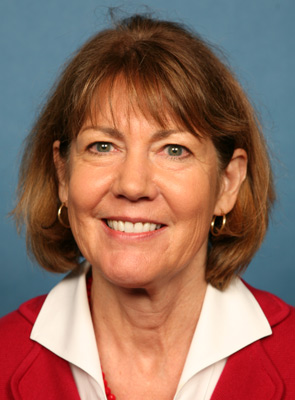Ann Kirkpatrick
Representative, 2009–2011, Democrat from Arizona
 Collection of U. S. House of Representatives, Photography Collection
Collection of U. S. House of Representatives, Photography CollectionAnn Leilia Kirkpatrick was born in McNary, Apache County, Arizona on March 24, 1950.2 Her father ran a general store in Whiteriver, Arizona, located in the Fort Apache Indian Reservation, and Kirkpatrick was raised speaking both English and Apache. She graduated from Blue Ridge High School in Pinetop-Lakeside, Arizona, in 1968. Four years later, she earned a B.A. in secondary education from the University of Arizona, and then worked as a substitute teacher to support her family after her father’s unexpected death the previous year. Kirkpatrick returned to the University of Arizona and earned a J.D. in 1979; she became the first female deputy county attorney in Coconino County in 1980. She also served as attorney for the city of Sedona before opening her own law firm in Flagstaff, a decision she described as “a leap of faith.”3 Her experiences as a small business owner and the daughter of a small business owner later informed her policy initiatives. Kirkpatrick married Roger Curley in 2009. She raised two daughters (Whitney and Ashley) from a previous marriage. She was an active member of the community for more than 25 years, serving on the water commission and as president of United Way of Northern Arizona.4
Kirkpatrick launched her political career in 2004 when she ran as a Democrat and won a seat in the Arizona state legislature. She worked to provide Indian tribes with funds to build communications infrastructure and lobbied the U.S. Department of Justice to rescind state election laws that disenfranchised Native Americans.5 Because Democrats were in the minority during her tenure, much of her legislative agenda never became law.6
Kirkpatrick gave up her state legislature seat in 2007 to run for an open U.S. House of Representatives’ seat when the Republican incumbent, Rick Renzi, declined to run for re-election, leaving the seat open. She ran in a largely rural district covering 58,000 square miles that included rugged desert, red rock country, tribal land, ranches, forest, and mining and agricultural towns in eight counties. One of the largest congressional districts in terms of land area, it encompassed an area roughly the size of Illinois and contained the tribal lands of the Navajo Nation. The diverse district also encompassed growing suburban towns in Florence and Casa Grande, the university setting of Flagstaff including Northern Arizona University and Coconino Community College, and tourist destinations like Sedona, Prescott, and the Grand Canyon. Kirkpatrick won the four-way Democratic primary with 47 percent of the vote. In the general election, she ran against anti-tax advocate, Sidney Hay. Kirkpatrick carried six of the eight counties in the district, winning 56 percent of the vote.7
Kirkpatrick was sworn in as a Member of the 111th Congress (2009–2011) on January 6, 2009, and received assignments on the Homeland Security, Veterans’ Affairs, and Small Business committees. Kirkpatrick supported two of her party’s three major legislative efforts: the economic stimulus plan in February 2009 and the health care bill in March 2010. However, she voted against the June 2009 House energy bill aimed at fighting climate change, citing the potential ensuing job losses at coal plants in her district.8
Kirkpatrick’s priority in the House was to improve the infrastructure in her district, including expanding basic services such as electricity, running water, telephone and Internet access. To this end, she worked with Senator John McCain of Arizona to advance legislation repealing a 40-year-old law, known as the “Bennett Freeze” Law, which had severely hindered economic growth on Native-American reservations in her district.9 H.R. 1762, which repealed Bennett Freeze, was signed into law on May 5, 2009. Kirkpatrick used her position on the Homeland Security Committee to push for bipartisan legislation to firm up the Mexican border and provide additional support to the Coast Guard to stem the drug trade into the United States. She also advocated for a pathway to citizenship for illegal immigrants as well as a temporary-worker program.10
In the 2010 midterm elections, Kirkpatrick was challenged by Republican Paul Gosar, a long-time dentist in her district supported by the Tea Party organization. Gosar painted Kirkpatrick as a party loyalist largely because of her support of the controversial Affordable Care Act and the federal stimulus. Claiming she was “kind of unhappy” with President Obama, Kirkpatrick rejected any support from the White House and distanced herself from the party.11 Despite her efforts to stand as a moderate and an outsider, Gosar won the election with 50 percent of the vote to Kirkpatrick’s 43.5 percent.12 After leaving the House, she resumed her work as an attorney in Flagstaff.
Further Reading
"Kirkpatrick, Ann," Biographical Directory of the U.S. Congress, 1774-Present, http://bioguide.congress.gov/scripts/biodisplay.pl?ndex=K000368.Footnotes
- Ann Kirkpatrick, “Energy Plan Will Take a Bite Out of Rural Ariz.,” Arizona Republic, 18 July 2009.
- “Ann Leilia Kirkpatrick,” Washington Post, n.d., http://projects.washingtonpost.com/2008/elections/az/house/1038/ann-leilia-kirkpatrick/.
- Politics in America, 2010 (Washington, D.C.: CQ Press, 2009): 34.
- “About Ann,” Congresswoman Ann Kirkpatrick, n.d., http://kirkpatrick.house.gov/index.php?option=com_content&view=article&id=112&Itemid=2 (website discontinued).
- Almanac of American Politics, 2010 (Washington: National Journal Group, 2009): 90–92.
- Cyndy Cole, “CD1 face-off a study in contrasts,” azdailysun.com , 25 October 2008, http://azdailysun.com/news/article_4d54ed1f-8dba-568a-99e3-ea20891f8669.html (Accessed 30 May 2012).
- “Election Statistics, 1920 to Present,” http://clerk.house.gov/member_info/election.aspx.
- Ronald J. Hansen, “Gosar Poses Big Challenge for Incumbent Kirkpatrick,” Arizona Republic, 5 October 2010.
- Congressional Record, House, 111th Cong., 1st sess. (21 April 2009): 4538–4539.
- Matthew Benson, “Immigration, Energy Policy Hot Topics in District 1 Debate,” Arizona Republic, 24 October 2008.
- Hansen, “Gosar poses big challenge for incumbent Kirkpatrick.”
- “Election Statistics, 1920 to Present.” http://clerk.house.gov/member_info/electionInfo/index.aspx.

